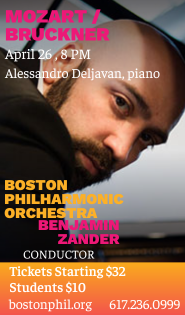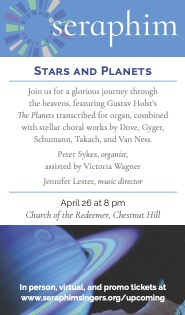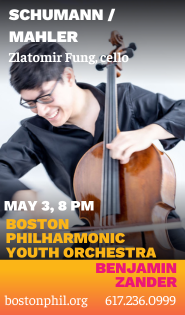Handel & Haydn opens a new century with dark drama of Mozart

Harry Christophers conducted the season-opening concert of the Handel and Haydn Society Friday night at Symphony Hall. File photo: Stu Rosner
The 1790s brought very different circumstances for Haydn and Mozart. The elder Haydn would go on to become the toast of London audiences, resulting in several concert trips to the city, a batch of works known collectively as the “London Symphonies,” and the oratorio The Creation by decade’s end. Mozart, however, died at the age of 35 in December of 1791, leaving behind an unfinished and mysterious final work, the Requiem in D minor.
The legacies of both composers owe much to these late pieces, some of which served as the main course in Friday night’s season opener of the Handel and Haydn Society, a concert led by Harry Christophers that kicked off the organization’s third century.
H&H gave the Boston premiere of Mozart’s Requiem in 1857 and has returned to the work fourteen times since, with the most recent performance occurring four years ago.
For this fitting season opener, Christophers led a richly dramatic rendering of the score. The conductor has a fine ear for large choral works and led with broad strokes and keen sense of the work’s architecture.
If the opening instrumental lines lacked the earthy power that is normally heard in performances of this piece, it’s because Christophers was getting to the good stuff as soon as he could. The H&H chorus proved to be the stars of the evening from the opening chords of the Introit, which sounded with full, resplendent tone.
At its height, Mozart’s choral writing flows in great, dark waves, the voices layering upon one another for an emotionally powerful, even overwhelming effect. The chorus was on top of it all, bringing off the score’s full-throated statements with intensity while paying attention to the finer details. In the “Lacrimosa,” Christophers built a long crescendo into powerful heights, and he guiding the bouncing lines of the “Kyrie” and the work’s myriad choral fugues with crisp precision.
Joining the chorus was a fine quartet of soloists.
Bass-baritone Dashon Burton possesses a deep and resonant voice that was well suited to the declamatory passages of the “Tuba Mirum.” Robert Murray answered with a warm, smooth-toned tenor, while mezzo-soprano Hannah Pedley and soprano Lauren Snouffer spun silky lines around each other in the closing stanzas of the movement. In the “Recordare,” the singers blended for shapely phrases that had the ensemble crispness of a well-trained choir.
Supplying the colorful and sturdy emotional energy to Mozart’s work was the H&H period-instrument orchestra. Playing with a pitch-perfect clarity that could match any modern ensemble, the musicians supplied the weight to Mozart’s score. The stirring lines of the “Confutatis” sounded with appropriate hellfire, while the phrases of “Hostias” seemed to glide heavenward.
The first half of the program was dedicated to works by Haydn and Samuel Webbe.
The Creation stands as one of Haydn’s crowning achievements, and it’s a work H&H knows well, given their acclaimed performance of the work this past spring as well as their recently released recording under the Coro label. Friday night, Christophers led the chorus and orchestra in a splendid rendering of selections from the monumental work.
The chorus sang with bold power and energy for “The heavens are telling the glory of God,” and the orchestra played a colorful depiction of a sunrise, making vivid the first day of creation as told in the Book of Genesis account.
The soloists, Snouffer, Murray, and Burton, blended with and balanced each other for a supple sound in the trio, “In all the lands resounds the word.”
Murray was a warm and clarion presence in the recitatives “And God said: Let there be lights” and “In splendor bright is rising now.” Christophers, leading with waving gestures, wove a silky bed of orchestral accompaniment.
The concert opened with Haydn’s tuneful Symphony No. 99 in E-flat major. Prepared in 1794 for the composer’s second trip to London, the symphony prominently features the use of woodwind instruments.
Christophers drew a performance that effectively captured Haydn’s characteristic wit and charm. The phrases of the first movement’s slow introduction were carefully sculpted for dramatic effect while the ensuing Vivace and Finale sounded light and dexterous in a brisk pace. Christophers also took time to shape the lines with accents and subtle dynamic shading.
The minuet was jaunty, with Christophers punctuating the texture with syncopations that sent the music effectively spinning off-center for a moment. The second movement was especially sensitive. The strings, with fine-tuned precision, played the aria-like melody with glowing tone, and flutes, oboes, clarinets, and bassoon blended sweetly for silky phrases.
Though unknown today, Samuel Webbe (1740-1816) was in his time the greatest English composer of glees, vocal songs set in three or four parts. Such music frequently found its way onto H&H programs two hundred years ago, and the composer’s When Winds Breathe Soft, heard Friday night, was performed on the society’s first concert in 1815.
It’s a tender song replete with silvery phrases, tight cat-and-mouse vocal writing, and colorful text setting. The H&H chorus sang with energy and diction of spring-water clarity to breathe new life into this charming artifact from the H&H archives.
The program will be repeated 3 p.m. Sunday at Symphony Hall. handelandhaydn.org;617-266-3605.
Posted in Performances



